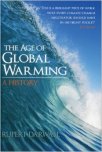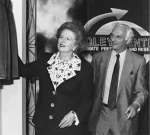Darwall tells how it was conservative governments who were the first to raise the alarm.
 In Australia and the USA today the politics of global warming falls fairly predictably across the right/left spectrum. Upon ascending to power in September, Tony Abbott could hardly wait to start abolishing a bunch of climate change qangos set up under Labor. Even before parliament had convened for the first time, the new conservative Australian government had launched their plan for rolling back Labor’s carbon tax and they had also sent into the latest round of UN treaty negotiation a strong message of resistance wrapped in anti-leftist sentiment.
In Australia and the USA today the politics of global warming falls fairly predictably across the right/left spectrum. Upon ascending to power in September, Tony Abbott could hardly wait to start abolishing a bunch of climate change qangos set up under Labor. Even before parliament had convened for the first time, the new conservative Australian government had launched their plan for rolling back Labor’s carbon tax and they had also sent into the latest round of UN treaty negotiation a strong message of resistance wrapped in anti-leftist sentiment.
[Australia] will not support any measures
which are socialism masquerading as environmentalism (1)
All this is reminiscent of 2001, when George W Bush could hardly wait to announce that he was rolling back the excesses of Clinton-Gore. The scene is not so straightforward in the UK. But even under David Cameron, where the old dark blue of the Tories has been lightened by a tide of green, warming alarm looks like a push from the left, while skepticism is a pushing back from the right. Lord Lawson’s launch in 2009 of the Global Warming Policy Foundation (to which John Howard recently gave a much publicized speech) fits with just such a pushing back against a weakening of conservative resolve. However, Rupert Darwall’s historical study, The Age of Global Warming, tells a more complex story, where there are deep historical sympathies of conservatism with the global warming scare. Moreover, it was conservative governments who succeeded in first raising the global alarm.
During the twilight years of her decade-long domination of British politics, Margaret Thatcher capitalised on her scientific background in four powerful and considered speeches on global warming.
The first of these was delivered in the autumn of 1988 to her fellows at the world’s premier state-instituted scientific organization, the Royal Society. Emphasizing greenhouse warming among international environmental concerns, this speech marked a volte-face for a government previously criticized as tardy in coming to the table on the other international environmental issues about which she boasted action, namely acid rain and ozone depletion. The surprise recruitment of Thatcher to the environmental cause undoubtedly added to the excitement generated in North America during that fateful summer of 1988 (see here). It added to the push within the United Nations for a climate treaty and for the strengthening of the mandate of the Intergovernmental Panel on Climate Change (IPCC).
While at the Royal Society, Thatcher cautioned the scientists that an assessment of the effects of greenhouse gas emissions should be ‘founded on good science to establish cause and effect,’ this message soon shifted. The following year Thatcher continued to emphasis ‘sound scientific analysis,’ but now as the basis of the measures taken to mitigate climate change. In a full 30 minute address to the UN General Assembly in November 1989, Thatcher left no doubt that immediate action on emissions is required. ‘We can’t just do nothing’ she insisted, and she joined the call for a framework convention followed by binding protocols to control emissions. Later in that session of the General Assembly, the World Meteorological Organization (WMO) and the UN Environment Program (UNEP) were directed to ask their newly established climate panel to go beyond their assessment of the greenhouse effect, of its impacts and of the various ways of mitigating climate change. The IPCC was also asked to begin preparations for just such a climate convention. In her UN speech, Thatcher boasted her government’s coordinating role in the IPCC, the report of which she said ‘will be available to everyone by the time of the Second World Climate Conference next year.’ But Thatcher herself was not going to wait that long.

Margaret Thatcher with John Houghton opening the Hadley Centre, May 1990. (Source: WMO )
The assessment of the scientific basis for action had been assigned to the IPCC Working Group I, which scheduled a meeting to finalise its report in Windsor, England, May 1990. These working group meetings are closed to the press while the governmental delegates agree line-by-line to a summary of the expert report. Once agreed, each of the three working groups then submits their report and summary to a full meeting of the IPCC, which, for the first assessment, would be held in Sundsvall, Sweden later in the year. Only once accepted by the panel would it become the official assessment of the panel. Just as Thatcher had indicated in her UN speech, the plan was to present to the world this freshly minted assessment at the Second World Climate Conference in November. However, in her UN speech Thatcher had also announced that the UK would establish a new centre for ‘the prediction of climate change.’ The opening of this ‘Hadley Centre’ was planned for the end of the week of the Working Group I meeting in Windsor the following May – long before the World Climate Conference. During the week, Thatcher had the British chair of the Working Group, John Houghton, brief her on the draft summary of the report. By incorporating the as-yet-unannounced working group findings into her opening speech, Thatcher achieved quite a scoop.

Gummer, Houghton, Major, Tickell & Selbourne at the launch of the Government Panel on Sustainable Development in 1994. (Source: WMO)
By this time the WMO’s World Climate Conference came around, environmental concerns were well established in Thatcher’s global policy profile, and there again she took the opportunity to join the chorus calling for action. But while Thatcher’s support undoubtedly empowered their cause, it is hard to see how this grandstanding on global action helped her win any support back home. Then perhaps, at that stage, nothing could; and returning home must have been a sobering experience for Margaret Thatcher. With the bright flame of Thatcherism receding, she arrived to find her government collapsing around her. It would soon die down into the smouldering and spluttering continuance of Tory government under John Major. Nevertheless, there remained John Gummer (Lord Deben), perhaps the most enthusiastic supporter of climate action of any member of any government of Great Britain. As environment minister under John Major, he would carry the flame for the Iron Lady all the way to Kyoto.
Sustainable Thatcher
Thatcher was astute with the science and sober in her assessment. Crispin Tickell, a prominent conservative diplomat, had encouraged her to take a stand on global environmental issues, and this one in particular, but she did not take his word for it, nor rely on political advisors. Instead, she consulted directly with Britain’s leading climatic researchers. These included John Houghton, who had been picked for his role in the IPCC while already the head of the British Meteorological Office. At times she also worked closely with Tom Wigley, the head of the Climatic Research Unit at University of East Anglia. Thatcher’s diligence with the science shows through in some of the most accurate and circumspect summaries of the IPCC’s assessment of any political leader at the time or since. Indeed, Tickell and Thatcher both recognised the speculative nature of the science as it stood. Thatcher even makes reference to the finding of Tom Wigley in his chapter of the IPCC assessment, which concludes that the human influence on global climate still had not been detected and that it is unlikely to be detected for decades. But Thatcher, again following Tickell (1986), did not see the lack of empirical confirmation as cause for delay in taking action to drastically reduce emissions. Thus, it was in full knowledge of the less-than-conclusive findings of the IPCC that Thatcher supported the plans to have a framework convention ready for signing at the Rio Earth summit in 1992, and for this to pave the way for protocols delivering legally binding emission reduction targets.
In her calls for climate action, it was a shock to many on both sides of the debate how Thatcher played the complete convert to the environmental cause. Her advocacy of precautionary action on prospective global warming was always presented in the context of a much grander cause which is the urgent need for cooperative action to protect the fragile global environment. In this she was early to embrace the language and scope of the ‘sustainable development’ movement as it had only recently been formulated in the Brundtland Report. After a late start, Thatcher had leaped to the front of the pack of world leaders campaigning on this issue. For it was only after she was prised off the stage by her Tory colleagues, only at the Rio earth summit in 1992, that all the aspirations of the sustainability movement was fully channelled into the campaign for a climate treaty.
Margaret Thatcher’s role in propelling the global warming scare onto the geo-political stage is only one small part of the story that Rupert Darwall offers in his The Age of Global Warming, a wide ranging study of the political phenomenon that is the global warming scare. But it is an important part, for it highlights the role that conservative governments played in the early scenes of this story. Their role is often neglected in other histories such as Booker’s less ambitious and much more readable The Real Global Warming Disaster.


